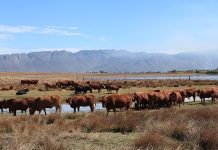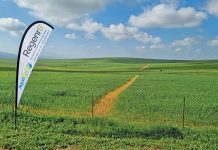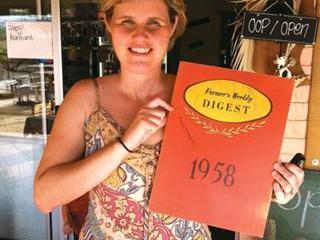Lutzville Vineyards is one of the largest wine cellars under one roof in South Africa, and also produces grape juice concentrate and wine alcohol. Annually they produce between 30 million litres and 40 million litres of wine.
The cellar also uses a measured average of 100 million litres of water a year. “During our peak production period between February and April, we use about 20 million litres of water a month,” says production manager Johan Schreuder. “Until a few years ago, we used to spray the resulting waste water onto adjacent vacant land, and that was that.”
Currently the waste water is sprayed onto 8ha of land belonging to the Matzikama municipality, but and the municipality are working on a project which would allow a community consortium of small farmers to grow commercial crops on this land, using the waste water and additional water from the Olifants River irrigation canal.
But first the water must meet Department of Water Affairs and Forestry (DWAF) standards. Hendrik Kröhn, director of technical services for Matzikama Municipality, says small farmers were identified for this project, but due to the criteria for water quality nothing has happened since.
After spending R3 million on a comprehensive water treatment and irrigation system, Lutzville would like to think that, with minor technical adjustments, the water quality can be improved to irrigation standard. The vacant land’s geological profile, location and irrigation scheduling ensure seepage into other water sources is unlikely.
Water goes to rehab
he waste water is about 50% of the initial volume the cellar receives. “Lutzville has a constant wind factor, making the evaporation rate quite high,” explains Johan.But the remaining water is the problem, as its chemical oxygen demand (COD) is extremely high. Wine waste water has a COD of 5 000mg/â„“, and water from the distillery can have a COD of between 20 000mg/â„“ and 25 000 mg/â„“. DWAF prescribes that if an irrigation system requires less than 500m³/day, treated water can only be released into it if the COD count is below 400mg/â„“.
Cellar waste water also differs significantly from municipal waste water. The winemaking process makes it very acidic, and different species of bacteria have to be used to treat it. Consequently the cellar can’t release its waste water into the municipal sewerage system.“Our treated waste water currently has a COD of between 2 000mg/â„“ and 7 000mg/â„“ during the peak season,” says Johan. Although still well above the COD stipulated by DWAF, research by the ARC at Nietvoorbij indicates this water is still suitable for certain crops – lucerne or kikuyu grass should thrive on it.
Lutzville’s cellar is washed each evening during the harvest season, and the waste water would normally be full of grape pips and skins. “Removing these products from our system significantly reduces the organic content of our waste water, even before it starts treatment,” says Johan.
he water is therefore passed through a screen filter to remove most solids: wine lees are also sold to a company that uses them to manufacture tartaric acid. Grape skins are sold to a nearby lime factory for furnace fuel, and farmers collect grape stems for composting.
The water is then combined with waste water from the distillery and concentrate facilities, diluting the distillery runoff. Because the microorganisms that will be introduced to treat the water can’t survive at the waste water’s normal low pH, lime is added to restore the pH to between 6 and 8.
The water is then pumped into the first of three settling dams, where the remaining solids are separated out, and then pumped into the treatment dams. “It’s crucial to remove as much solid material from the water as possible, as this is a major cause of pump corrosion,” says Johan.
The water is passed through an aerating pump system where selected bacteria consume the organic matter in it, lowering COD levels.
“There are three stages to this process,” Johan explains. “In the first dam, water is circulated and aerated. Bacteria are introduced and stimulated with additional urea and nitrogen.From the second dam, a portion of the water is returned to the first dam with a venturi pump system that exposes it to additional oxygen. The water then flows into the third dam.
Its COD has now been reduced to between 2 000mg/â„“ and 7 000mg/â„“ and it can be used on selected crops on specific soils.” Stalled at the last lap Current water legislation prohibits mixing waste water with clean water for irrigation. This is a problem for the community project, as the cellar water will have to be augmented with canal water.
“We’re applying for a license and appealing to the department to be more lenient on its COD guidelines,” says Johan. DWAF and Winetech are currently negotiating realistic water quality standards for wine cellars regarding beneficial irrigation applications.
Johan Matthee from the Lower Olifants River Water Consumers’ Association says water to irrigate 2ha would be available from the canal for such a project.“If the proposed enlargement of the Olifants River Dam happens, we might be able to allocate the additional water required to develop the full 8ha,” he says.Contact Johan Schreuder on (027) 217 1516. |fw
Nematodes-resistant soya beans
Nematodes are minute worm-like pests that feed on plant roots, robbing them of nutrients and water. They attack a wide range of food crops and may cause major losses. US scientists have now identified soya bean varieties that are resistant to both the cyst nematode and the root-knot nematode.
Scientists from Purdue University in the screened soya bean varieties for resistance in known nematode-infested farm soils, artificially infested soils, and in greenhouse tests. Cyst-nematode-resistant varieties aren’t necessarily resistant to other nematode species, as the genetic mechanisms are different.
However, several varieties have now been identified that are resistant to both cyst and root-knot species. Research will extend to cover crops to reduce renewed build-up of nematodes.Cyst nematodes produce small white or yellow galls on the surface of roots, while root-knot nematode – caused by Meloidogyne incognita – causes large, irregularly shaped galls like warts, which are easily distinguished from the round galls of beneficial, symbiotic, nitrogen-binding Rhizobium bacteria.
Plants are usually infected in patches and will show stunting and yellow, chlorotic leaves. To date there are only two solutions: using resistant crop varieties, or chemically treating soil or seed. Chemical treatments for soils are expensive, not very practical and could lead to persistence of pesticides that may pose risks to humans, animals and the environment.
Maize, soya beans, vegetable crops like watermelon and tomatoes, and some cover crops, are all susceptible to nematodes. This rules out crop rotation as a solution to the nematode problem. – Wynand van der Walt ([email protected])
Source: Purdue University, March 2008. |fw









